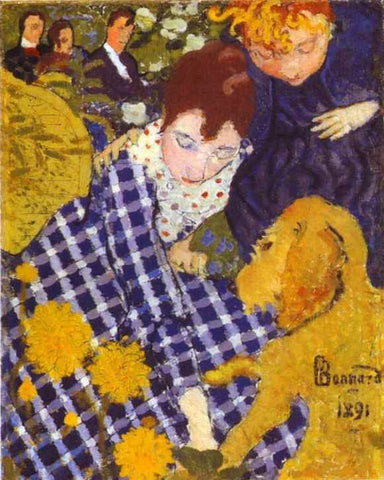.Bonnard - Part 1
Painting by Pierre Bonnard from 1940, “The Garden Staircase”.
For a long time, it was not fashionable to like the ultra-colorful works of Pierre Bonnard (1867-1947). At 24, Bonnard said he was from no school, and built his work outside the mainstream. Certainly, he joined for a time with the Nabis ("prophets" in Hebrew), a movement which sought to recreate a form of sacred art with very colorful and almost abstract canvases. But it was to isolate himself better afterwards. Geographically first: Pierre Bonnard creates most of his paintings in Normandy, then in Le Cannet, on the Côte d'Azur, far from the hustle and bustle of Paris.
Artistically, then: he missed the great revolutions of his time, cubism, surrealism... provoking the disdain of some contemporaries, like Picasso who had particularly harsh words against the "sensitivities" of Bonnard.
I understood very late what my grandfather said who considered Bonnard to be the absolute master of the 20th century.
Pierre Bonnard, in November 1889, took the lawyer's oath. What a journey! Matisse was a notary's clerk.
Here he is with his beloved dachshund. He had several: Ubu, Black, Poussette and Dingo, we find them in many of his paintings.
Bonnard is the first artist who believed in my grandfather, Aimé Maeght.
Aimé Maeght said, "Without Bonnard, I would perhaps have continued like the other dealers. Bonnard arrived at the moment in my life when I wanted to make this big leap towards modern art and it was him, first his painting and by the many reflections and the numerous discussions that we had together, which made me understand what modern art could be." Aware of meeting an exceptional man, my grandfather filmed him in his daily life, thus making the only films in the world of this genius of art history.
“The toilet”, circa 1908
Bonnard chooses a sophisticated composition to feature Marthe, his companion and exclusive model, represented here both from the back and from the front thanks to the reflection of the mirror. The importance of the decoration as well as the presence of truncated or distorted elements, such as the pedestal table on which a pitcher is placed, push the composition towards a decorative abstraction characteristic of this period of Bonnard's creation. Retouched by the artist between 1914 and 1921, the painting is part of a period of doubt and questioning; after the Cubist surge, Bonnard returned to the basics of painting.
Bonnard couldn't help but retouch his works, walking around with a box of colors in his pocket, including in museums. Bonnardize or bonnarder have entered common parlance meaning retouching a work of art that one has created, including without the knowledge of its new owners.
Pierre Bonnard, “Interior with Flowers”, 1919.
In 1890, Pierre Bonnard shared a workshop with Vuillard and Marice Denis. It was then that he began to make color lithographs. The following year, 1891, he met Henri de Toulouse-Lautrec and presented his first exhibition at the Salon des Indépendants and in the first Nabis exhibitions. He exhibited with the Nabis until their dissolution in 1900.






